Sphere Lenses
Singlet Spheres
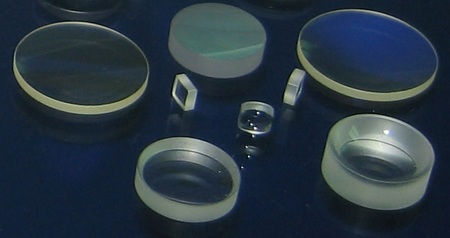
This high standard of quality provides exceptional performance in demanding applications. For high energy laser applications.
Optical lens are used to converging or diverging the light, it is widely used in microscopy, laser, image, light etc. So it requires different materials for different work range. CPG optics handle from UV Materials from deep IR materials. With our closely QA process, each lens is guaranteed for all your needs.
In some meanings, we can say, each elements in optics can’t work with coatings, so CPG also provide different coating for, from mental to dielectric, surely CPG will be your best choice.
Materials: BK7/Fused Silica/Germanium/Silicon/GaAs etc.
Typical Specification
| Param Name | Param Value |
|---|---|
| Material | UV/VIS/FIR |
| Shap | Spherical P-Concave, P-Convex, Bi-concave, Bi-convex, Concave-Convex or Aspheric |
| Surface Figure | 1/10 at 633nm before coating |
| Surface Quality | 10-5 Laser Quality |
| Dimension Tolerance | +0.0, -0.1mm |
| Thickness Tolerance | +/- 0.1mm |
| Chamfer | 0.35mm at 45° typical |
| Concentricity | 0.05mm |
| Focal Length Tolerance | +/- 0.5% typical |
| Clear Aperture | Exceeds central 85% of dimension |
Cemented Spheres

CPG provide a lot of cemented spheres, like we all know there are always aberration for singlet, so doublet for triplet even multi-cemented sphere are designed and used in the optical systems, there are spherical aberration, There are several common aberrations: spherical aberration, coma and Chromatic aberration etc.
Spherical aberration occurs because spherical surfaces are not the ideal shape with which to make a lens, but they are by far the simplest shape to which glass can be ground and polished and so are often used. Spherical aberration causes beams parallel to, but distant from, the lens axis to be focused in a slightly different place than beams close to the axis. This manifests itself as a blurring of the image. Lenses in which closer-to-ideal, non-spherical surfaces are used are called aspheric lenses. These were formerly complex to make and often extremely expensive, but advances in technology have greatly reduced the manufacturing cost for such lenses. Spherical aberration can be minimized by careful choice of the curvature of the surfaces for a particular application: for instance, a Plano-convex lens which is used to focus a collimated beam produces a sharper focal spot when used with the convex side towards the beam source.
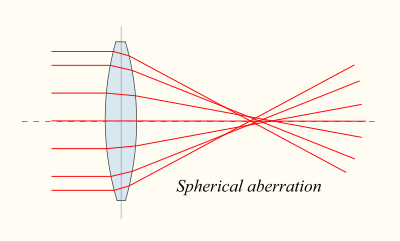
Coma occurs when an object off the optical axis of the lens is imaged, where rays pass through the lens at an angle to the axis θ. Rays which pass through the centre of the lens of focal length f are focused at a point with distance f tan θ from the axis. Rays passing through the outer margins of the lens are focused at different points, either further from the axis (positive coma) or closer to the axis (negative coma). In general, a bundle of parallel rays passing through the lens at a fixed distance from the center of the lens are focused to a ring-shaped image in the focal plane, known as a comatic circle. The sum of all these circles results in a V-shaped or comet-like flare. As with spherical aberration, coma can be minimized (and in some cases eliminated) by choosing the curvature of the two lens surfaces to match the application. Lenses in which both spherical aberration and coma are minimized are called best form lenses.
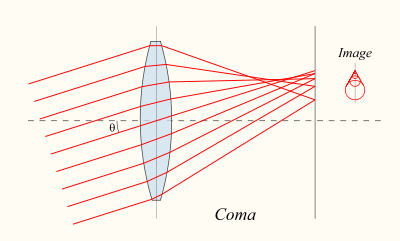
Chromatic aberration is caused by the dispersion of the lens material—the variation of its refractive index, n, with the wavelength of light. Since, from the formulae, f is dependent upon n, it follows that different wavelengths of light will be focused to different positions. Chromatic aberration of a lens is seen as fringes of color around the image. It can be minimized by using an achromatic doublet (or achromat) in which two materials with differing dispersion are bonded together to form a single lens. This reduces the amount of chromatic aberration over a certain range of wavelengths, though it does not produce perfect correction. The use of achromats was an important step in the development of the optical microscope. An apochromat is a lens or lens system which has even better correction of chromatic aberration, combined with improved correction of spherical aberration. Apochromats are much more expensive than achromats.
Different lens materials may also be used to minimise chromatic aberration, such as specialised coatings or lenses made from the crystal fluorite. This naturally occurring substance has the highest known Abbe number, indicating that the material has low dispersion.
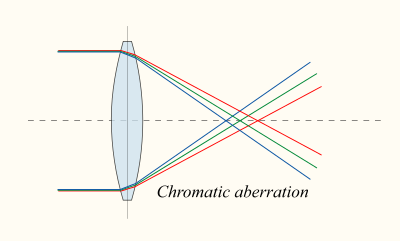
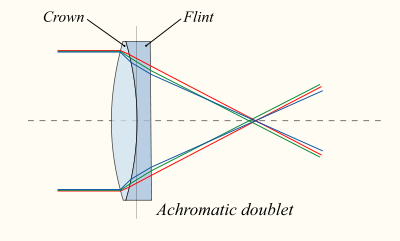
Typical Specification
| Param Name | Param Value |
|---|---|
| Diameter Tol | +/-0.02mm or loser |
| CT Tol | +/-0.05mmmm |
| Radius | R1=R1+/-0.03mm CX R3=R3+/-0.0025mm CX |
| Surface Accuracy | N 2 fringes,△N 0.5 fringes Scratch & dig: 40-20 (Before), 60-40 (After coating) Centration < 5 arc min |
| Coating | Surface A and C:AR coating R < 1.5%@800-1650nm or upon request |